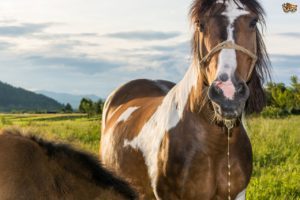#AskTheVet with Dr. Lindsay Annis
Question: Is there any way to treat slobbers? I try to pull the clover from the fields but my horse is still drooling everywhere! 
(photo pulled from Google)
Answer: Clover can become infected by a fungus called Rhizoctonia leguminicola, also known as black patch disease, so named because it can be seen on the leaves as colored spots or rings. The toxic substance in the fungus (mycotoxin) that causes equine slobbers is an indolizidine alkaloid called Slaframine. Slobbers is commonly seen in the summer months during weather conditions such as high humidity, overgrazing, extreme heat or cool, wet periods. Horses are highly sensitive to slaframine and when they ingest it, it causes hypersalivation.
There is no treatment for slobbers except to move the horse to a field without clover, or reduce/remove the clover from the fields. Some suggestions for pasture management include mowing the field down, reducing the ratio of clover in the field by seeding other grasses, pasture rotation, fertilization and using a pasture friendly broadleaf herbicide to eliminate the clover.
The good news is that slobbers is not life threatening. Because horses can lose a lot of saliva when they have the slobbers, it is important to make sure that your horse always has free access to fresh water and a salt or mineral block to prevent dehydration or electrolyte imbalances. Hypersalivation will resolve on its own in a few days once the horse stops consuming the mycotoxin infected clover. If your horse displays any other clinical signs besides excess saliva production, I recommend that you get in touch with your veterinarian to make sure that there is not something else going on.
Recent Posts
About Us
At B.W. Furlong & Associates, we are progressive leaders delivering the ultimate in veterinary care to our equine patients and clients in both the hospital and ambulatory setting. We have several associated practices offering exemplary care and services in New Jersey, Florida, and Virginia
